Introduction - Why Carbon Neutral?
The greening of North American building seems to be taking hold. The intended market transformation of the LEED® Certification system appears to be working. Statistics show that the numbers of certified green buildings in both the United States and Canada are increasing at an exponential rate. The proposed changes to the USGBC version of LEED® – 2009/V.3 – are intended to support changes in the system that recognize differences in credit values as well as regionalized differences in the required approach to green building. The introduction of LEED® for Homes and Neighborhoods has extended the potential influence of the program beyond the original commercial building marketing target. ASHRAE’s proposed Standard 189.1 is also taking aim at increasing the standards for High-Performance Buildings of a non low-rise residential variety.
However, with continuing environmental degradation, and more recent escalating concerns about Global Warming and CO2 levels in the environment, it is becoming clear that even the highest standards of construction that are being implemented in North America today are simply not enough. Green buildiing has evolved to be a very holistic approach to design. While this is not incorrect in that building and construction has grown to have a very pervasive and negative impact on the environment in general, Global Warming is particularly concerned with greenhouse gas emissions, and these arise from very focused aspects of design and construction.
While the design and construction industries in the United States and Canada scramble to adopt and evolve green/sustainable building guidelines such as LEED® to increase their rigor and range of applicability, the United Kingdom is advancing in the implementation of regulations that are specifically intended to control carbon emissions, and not just for commercial buildings. Discussion and regulations in the UK are aimed not just at CO2, but at CO2e.
CO2e: The universal unit of measurement used to indicate the global warming potential (GWP) of each greenhouse gas . Carbon dioxide (CO2) is a naturally occurring gas that is a byproduct of burning fossil fuels and biomass, land-use changes, and other industrial processes. CO2 is used as the reference gas against which the other greenhouse gases are measured since it has the smallest GWP. CO2 emissions are reported in CO2e; the standard unit is MtCO2e or metric tons or tons of carbon dioxide equivalent. The global warming impact of all greenhouse gases is measured in terms of equivalency to the impact of carbon dioxide (CO2) via global warming potentials. For example, one million tons of emitted methane, a far more potent greenhouse gas than carbon dioxide, is measured as 23 million metric tons of CO2 equivalent, or 23 million MtCO2e.  |
Great Britain has already adopted policies that require all new housing stock to be Carbon Neutral by the year 2016. They are working towards the implementation of carbon taxes to motivate companies to look closely at the way that they consume energy and goods, and reward citizens that show initiative in responding to this crisis. The act of carbon counting is beginning to permeate a multitude of sectors in the UK. (More info on work in the UK)
The issue of carbon is not a simple one. There is carbon involved in the extraction of the resources that we use to create products; in the transportation of these products to the site; in the physical construction of the buildings; in the operation of buildings; and in the lives of people as they carry on business. In order to be able to reach a state of “carbon neutrality”, lifestyle changes will be necessary. The status quo cannot be simply modified to reduce its carbon cost. Consumption patterns must change. Buildings and their programs may require downsizing or creative reinvention. Understanding the definitions of the terms that are associated with this elevated movement is important.
What is Carbon Neutral?
Carbon Neutral Design is a subset of Sustainable Design. Buildings that are currently including issues of sustainable design in their mandate, are likely already addressing some aspects that support carbon reductions. The issue of carbon in buildings is complex. There is carbon involved in the extraction of the resources that we use to create products; in the transportation of these products to the site; in the physical construction of the buildings; in the operation of buildings; and in the lives of people as they carry on business.
Holistic carbon neutral design is looking to reduce the carbon emissions associated with all aspects of the project. This would include the operating energy as well as the construction and materials, and additionally the carbon associated with the commercial, institutional or residential use of the building by the occupants. This incorporates the nature of the work or activity that is carried on within a building. Locating the building to reduce transportation costs will factor into this equation, and thereby includes neighborhood and local or regional planning issues.
Zero Energy Design (ZED) differs from Carbon Neutral Design (CND) in that it is more concerned with the reduction of the operating energy requirements for a building, focusing on the eventual use of zero fossil energy. The official ASHRAE definition for a Net Zero Energy building is “buildings which, on an annual basis, use no more energy than is provided by on-site renewable energy sources.” The Office of Energy Efficiency and Renewable Energy provides an array of definitions for Net Zero Energy Buildings, based on the base premise that, “A net ZEB produces as much energy as it uses over the course of a year. Net ZEBs are very energy-efficient buildings, with the remaining low energy needs typically met through the use of on-site renewable energy.”  The Department of Energy provides supplementary definitions based upon the cases of Net Zero: Site Energy, Source Energy, Energy Costs, Energy Emissions and Energy. Preferred renewable resources would be solar and wind, but renewable resources can include biomass, wood chips and other waste materials, as long as they are from renewable sources. Obviously the burning of any type of fuel, fossil or renewable, results in emissions – creating one of the significant differences of the goals of Zero Net Energy and Carbon Neutral Design. The Department of Energy provides supplementary definitions based upon the cases of Net Zero: Site Energy, Source Energy, Energy Costs, Energy Emissions and Energy. Preferred renewable resources would be solar and wind, but renewable resources can include biomass, wood chips and other waste materials, as long as they are from renewable sources. Obviously the burning of any type of fuel, fossil or renewable, results in emissions – creating one of the significant differences of the goals of Zero Net Energy and Carbon Neutral Design.
ZED buildings take advantage of the sun and wind, employing a high degree of passive solar heating, natural ventilation and daylighting, to reduce their energy requirements. They are typically super insulated, and also use higher quality glazing systems. Their interior finishes include thermal mass to store the free heat they capture from the sun. They will generate their own electricity through wind turbines, photovoltaics and micro generation facilities. Their goal is to be able to generate more electricity than they require for operation. These design intentions are shared with Carbon Neutral buildings.
Definitions
Net Zero
These definitions have been taken from http://www1.eere.energy.gov/buildings/commercial_initiative/zero_energy_definitions.html
Net Zero Site Energy
A site zero energy building produces at least as much energy as it uses in a year, when accounted for at the site. The measurement time frame is annual.
Net Zero Source Energy
A source zero energy building produces at least as much energy as it uses in a year, when accounted for at the source. Source energy refers to the primary energy required to generate and deliver the energy to the site. To calculate a building's total source energy, imported and exported energy is multiplied by the appropriate site-to-source conversion multipliers.
Net Zero Energy Costs
In a net zero energy costs building, the amount of money the utility pays the building owner for the energy the building exports to the grid is at least equal to the amount the owner pays the utility for the energy services and energy used over the year.
Net Zero Energy Emissions
A net zero energy emissions building produces at least as much emissions-free renewable energy as it uses from emission-producing energy sources annually. Carbon, NOx, and SOx are common emissions that ZEBs offset.
Near Zero Energy
A near zero energy building produces at least 75% of its required energy through the use of on-site renewable energy. Off-grid buildings that use some non-renewable energy generation for backup are considered near zero energy buildings because they typically cannot export excess renewable generation to account for fossil fuel energy use.
Carbon Neutral
Carbon Neutral - Operating Energy
The base definition for Carbon Neutral Design is taken from www.architecture2030.org. Carbon neutral with respect to Operating Energy means using no fossil fuel GHG emitting energy to operate the building. Building operation includes heating, cooling and lighting. These targets may be accomplished by implementing innovative sustainable design strategies, generating on-site renewable power and/or purchasing (20% maximum) renewable energy and/or certified renewable energy credits.
According to the Carbon Neutral Design Protocol Tool developed for this project, this includes Scope 1 Carbon due to Direct Emissions as well as Scope 2 Carbon due to Indirect Emissions.
It is felt that at the present time, Operating Energy accounts for approximately 70% of the Carbon Emissions associated with a building.
Carbon Neutral - Operating Energy + Embodied Energy
This definition for Carbon Neutrality builds upon the definition above and also adds the Carbon that is a result of the Embodied Energy associated with the materials used to construct the building. This value is far more difficult to calculate.
The initial embodied energy in buildings represents the non-renewable energy consumed in the acquisition of raw materials, their processing, manufacturing, transportation to site, and construction.
This initial embodied energy has two components:
Direct energy the energy used to transport building products to the site, and then to construct the building; and
Indirect energy the energy used to acquire, process, and manufacture the building materials, including any transportation related to these activities.
The recurring embodied energy in buildings represents the non-renewable energy consumed to maintain, repair, restore, refurbish or replace materials, components or systems during the life of the building.
As buildings become more energy-efficient, the ratio of embodied energy to lifetime consumption increases. Clearly, for buildings claiming to be "zero-energy" or "autonomous", the energy used in construction and final disposal takes on a new significance.
Carbon Neutral - Operating Energy + Site Energy + Occupant Travel
This definition of Carbon Neutrality builds upon the inclusion of Operating Energy and Embodied Energy, and also reflects the carbon costs associated with a building's location. This requires a calculation of the personal carbon emissions associated with the means and distance of travel of all employees and visitors to the building. This is referred to as Scope 3 Carbon due to Indirect Emissions (organizational travel). |
How does Carbon Neutral Design Differ from Existing Sustainable Design Protocols?
Interest in the negative impact of buildings on the environment can likely be dated back to the publication of "Silent Spring" by Rachel Carson in 1962. "Design With Climate", 1963, by Victor Olgyay was the first book to take a critical look at the need to relate building design to climate, and to take on issues of human comfort in building as well as the potentiality of vernacular and indigenous design. Olgyay's influential book began to define environmental performance in terms of passive design principles, that additionally related performance to human comfort. Contrary to what had evolved with the advent of mechanical systems for heating and cooling that ensured a specific temperature and relative humidity 24/7, the bioclimatic approach spoke of a "comfort zone" (the gray kidney shaped area at the center of the diagram below).
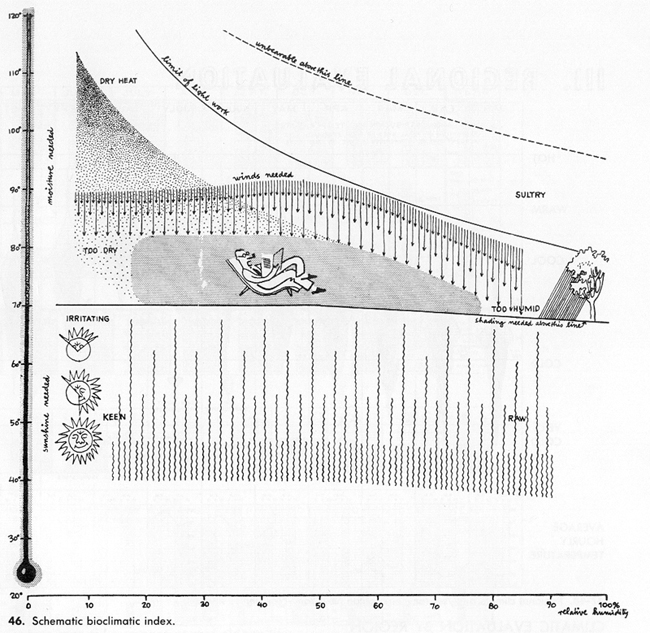
"THE COMFORT ZONE"
The Bioclimatic Comfort Chart
Victor Olgyay "Design With Climate" 1963
(sadly this book is out of print and only available from resellers at exorbant prices)
The potential for a positive connection between building and nature was also highlighted in Ian McHarg's "Design with Nature" in 1969. The general level of architectural interest in this environmentally sensetive approach to building was not mainstream.
Positive changes to the way that buildings were to be designed arose in part as a reaction to the Energy Crisis of the 1970s. The initial reaction to the energy crisis was to increase the energy performance requirements in the Building Code (including increased insulation levels and increased air tightness requirements).
Through the 1980s and 1990s, the notion of Sustainable Design grew to be more holistically considered, and expanded to encompass issues related to materials, sites, water and indoor environmental quality. A range of green building rating systems, protocols, guidelines and standards has been developed over the last 10 to 15 years that respond to the need to evaluate and benchmark levels of achievement in this holistic pursuit of Sustainable Design. In North America, LEED® has likely become the forerunner of these, although Green Globes has been adopted by some municipalities and groups as their assessment tool of choice. Both of these systems have looked at the notion of ratings as a potential way to market buildngs, and the means to transform the market.
Except as adopted by local governments that are keenly engaged in environmental issues, none of the current green ratings systems forms a legal requirement as part of a building permit process. The current legal mandate of North American Building Codes is to provide a set of minimum requirements for Fire and Life Safety in buildings. At present they also largely include minimum requirements for insulation and window performance, and some also speak to air infiltration and air leakage. This varies by region and jurisdiction. A building that is constructed to meet the Building Code is generally speaking not considered to have engaged even remotely in the creation of a green building. The exception to this would be the State of California which has just announced the first “green” building code. Title 24  sets targets for single family homes, health care facilities and commercial buildings, to become mandatory in 2010. sets targets for single family homes, health care facilities and commercial buildings, to become mandatory in 2010. , , The new California Green Building Standards Code calls for a 15% reduction in building energy use over the current standards, a 50% landscape water use reduction, and significant improvement in efficiencies for commercial and residential plumbing fixtures. The code also encourages the use of recycled materials and identifies various site improvements including parking for hybrid vehicles and more stringent management of storm water. In the Province of Ontario, Canada, the Government has recently introduced legislation in the form of a "Green Energy Act" that is intended to look to to incrementally rachet up the energy performance levels of basic Code Compliant buildings. The new California Green Building Standards Code calls for a 15% reduction in building energy use over the current standards, a 50% landscape water use reduction, and significant improvement in efficiencies for commercial and residential plumbing fixtures. The code also encourages the use of recycled materials and identifies various site improvements including parking for hybrid vehicles and more stringent management of storm water. In the Province of Ontario, Canada, the Government has recently introduced legislation in the form of a "Green Energy Act" that is intended to look to to incrementally rachet up the energy performance levels of basic Code Compliant buildings.
An assessment of existing protocols in sustainable building design would indicate that there are clear “levels” of performance when verifying the actual “greenness” of a building or development. The ability to numerically validate criteria is essential to the establishment of a classification of “high performance”. The term “high performance” has been adopted in the field of green building in lieu of the term “sustainable”, which although holistic and forward thinking, remains unscientific.
The key difference between Carbon Neutral Design and Sustainable Ratings Systems lies in the very specific focus on carbon reduction, versus the very broad and holistic mandate of Sustainable Rating Systems, which include ALL aspects of the impact of the building on the environment. It is quite possible to design a Sustainable Building (by definition of LEED® or Green Globes) that does little to reduce its carbon footprint.
An examination of the state of LEED®, Green Globes and ASHRAE Standard 189.1 in 2008 reveals that none of the systems include Carbon calculations (detailed or schematic) in their mandatory or optional credits.
LEED® and Carbon
The LEED® Rating System for New Commercial Buildings assigns its credits in 6 categories. If looking to target Carbon Neutrality in the Operating Energy of a building, in alignment with the intentions of the 2030 Challenge, the primary focus of design modifications would fall in the Energy and Atmosphere category. LEED® V2.1 requires that the building be designed to comply with ASHRAE/IESNA Standard 90.1-1999 (without amendments) or the local energy code, whichever is more stringent. Improvements on this level of energy efficiency can earn up to 10 credit points. The maximum suggested reduction over Standard 90.1-1999 is 60% for new buildings and 50% for existing buildings. LEED® Guidelines outline a three step approach to optimizing the energy efficiency of buildings: demand reduction, harvesting free energy and increased efficiency. The LEED® requirement for LEED® 2009 has recently been announced to be upgraded to increase the Minimum Energy Performance prerequisite requirements; update to ASHRAE 90.1-2007 for energy requirements; and include other energy efficiency enhancements, including increased incentive for On-Site Renewable Energy. The LEED® requirement for LEED® 2009 has recently been announced to be upgraded to increase the Minimum Energy Performance prerequisite requirements; update to ASHRAE 90.1-2007 for energy requirements; and include other energy efficiency enhancements, including increased incentive for On-Site Renewable Energy.
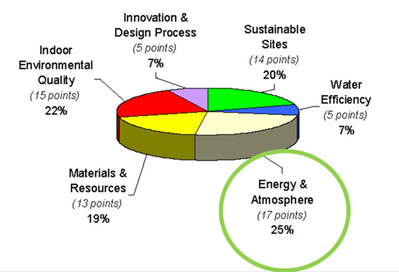
The LEED® Pie
It is possible to achieve LEED® Gold and Platinum status without significantly reducing the carbon emissions that result from operating energy. A building that is targeting Carbon Neutrality with respect to its operating Energy MUST achieve all of the credits associated with optimizing energy, and more.
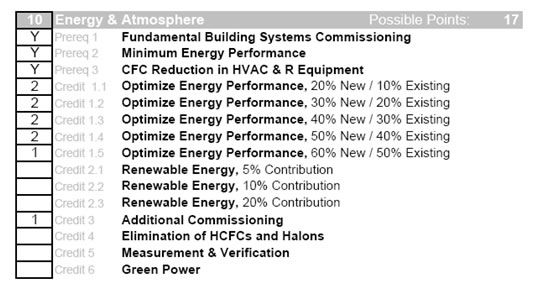
LEED®Scorecard for the Vancouver National Works Yard - LEED® Gold
The breakdown of the Energy and Atmosphere Credits illustrates that the highest level of Optimization awarded is a 60% increase in performance levels. This gives 10/10 points. A building can become certified by only meeting the Minimum Energy Performance Criteria. The maximum target for renewable energy is a 20% contibution. A building can become Certified without using any renewable energy. Green Power is also optional. This would illustrate that environmentally motivated design that is presently using LEED® as the basis for decision making, needs to carefully examine the credits and proceed to substantially exceed many key areas in Energy & Atmosphere.
ASHRAE Standard 189.1 and Carbon
The proposed ASHRAE Standard 189.1 “Standard for the Design of High-Performance, Green Buildings Except Low-Rise Residential Buildings” is intended to work not to compete with, but as a complement to LEED®, yet claims similar ground or topic areas. Its criteria mirror existing rating systems such as LEED®  and Green Globes and Green Globes . Its intention is to establish increased mandatory criteria in all topic areas as one “problem” its proponents see with existing rating systems is that they contain few mandatory provisions and consequently, a designer can achieve “points” and claim that they have a “green building”, but still make no improvements in some areas. Hence not only is the adoption of the rating system optional, but so are many critical credits. . Its intention is to establish increased mandatory criteria in all topic areas as one “problem” its proponents see with existing rating systems is that they contain few mandatory provisions and consequently, a designer can achieve “points” and claim that they have a “green building”, but still make no improvements in some areas. Hence not only is the adoption of the rating system optional, but so are many critical credits.
ASHRAE Standard 189.1 intends to provide simple compliance options in reaction to a critique of existing rating systems that require extensive calculations to satisfy compliance. Standard 189.1 targets larger commercial buildings of 4 stories or greater and purposefully excludes single-family housing, multi-family structures of three stories or fewer above grade, manufactured houses (mobile homes) and manufactured houses (modular). These are deemed to be outside of the mandate of the High Performance Building type. Standard 189.1 targets larger commercial buildings of 4 stories or greater and purposefully excludes single-family housing, multi-family structures of three stories or fewer above grade, manufactured houses (mobile homes) and manufactured houses (modular). These are deemed to be outside of the mandate of the High Performance Building type.
Standard 189.1 intends to provide simple compliance options in reaction to a critique of existing rating systems that require extensive calculations to satisfy compliance. The structure of the Standard 189.1 topic areas is divided into mandatory credits that are required by all projects, plus prescriptive and performance options that are not required. The prescriptive options are intended to be simple, therefore requiring very few calculations, encouraging compliance. The performance options are more sophisticated in their requirements (i.e. calculations) and so will require more effort, and by extension, less likely to be achieved. The topic categories are: Sustainable Sites (3 mandatory, 1 prescriptive/1 performance); Water Use Efficiency (3 mandatory, 2 prescriptive/performance); Energy Efficiency (3 mandatory, 1 prescriptive/performance); Indoor Environmental Quality (IEQ) (7 mandatory, 2 prescriptive/performance); The Building’s Impact on the Atmosphere,Materials and Resources (4 mandatory, 1 prescriptive/performance); Construction and Operation Plans (9 mandatory, 0 prescriptive/performance).
ASHRAE Standard 189.1, in addition to its mandatory renewable energy element, also mandates metering, meter data collection, and data storage and retrieval. It offers prescriptive and performance options that include considerations of building envelope design, insulation levels, electrical and mechanical equipment.
Green Globes and Carbon
Green Globes is operated differently in Canada and the United States. Green Globes devotes 380/1000 points towards energy efficiency. It benchmarks against the Model National Energy Code for Buildings in Canada, with the highest level of performance suggested to be less than 10 kWh/sf-yr, or less than 388 MJ/m2-yr or 50% or more reduction of MNECB. Green Globes credit C.2 is of interest to carbon design as it explicitly awards 114/1000 potential points for a reduction in demand. These include: space optimization, response to microclimate and geography, building envelope, integration of daylight and integration of sub-metering.
The Green Building Initiative is in the process of transforming Green Globes into an ANSI Standard: GBI Proposed American National Standard 01-2008P: Green Building Assessment Protocol for Commercial Buildings. Although this Standard will include some carbon protocol, it again excludes the residential building type. This new protocol places a much greater emphasis on carbon. Of its 1,000 points, 250 are specifically targeted at carbon. One hundred and fifty points are awarded for a 50% reduction of carbon dioxide equivalent emissions. An additional point is awarded for every further 1% increase in reductions. The updated version will incorporate the Athena EcoCalculator to begin to also assess the embodied carbon in the building. For more information on these upcoming changes, please read "DEVELOPING AN OPERATIONAL AND MATERIAL CO2 CALCULATION PROTOCOL FOR BUILDINGS" by Harvey Bryan, Ph.D., FAIA and Wayne B. Trusty, MA. The updated version will incorporate the Athena EcoCalculator to begin to also assess the embodied carbon in the building. For more information on these upcoming changes, please read "DEVELOPING AN OPERATIONAL AND MATERIAL CO2 CALCULATION PROTOCOL FOR BUILDINGS" by Harvey Bryan, Ph.D., FAIA and Wayne B. Trusty, MA.
Layers of Green: Adding Carbon to the Sustainability Equation
The issue of Global Warming, although arising from the arena of sustainable concern about the state of the built environment, is more specifically concerned with greenhouse gas emissions, than it is about more holistic environmental concerns. It is the level of CO2 that is the direct byproduct of the building industry that requires modification to existing Green Building Protocols to either deepen or include its consideration.
The United Kingdom’s White Paper on Carbon Emissions, “Climate Change: The UK Program 2006” has set out very aggressive targets to meet and exceed their Kyoto promises. Interestingly in the UK model, it is the residential building sector that is receiving the maximum attention, not commercial buildings. This is in absolute contrast to the status quo in North America, which is only now beginning to develop green building assessment protocols for the residential sector. Additionally the UK government has sanctioned the construction of a number of “Eco Towns” across Great Britain. Part of the low carbon strategy that is being incorporated into the design of these developments requires increased dependency on renewable energy, much of which makes better economic sense as when attempting to implement district heating and cooling. This integrated community planning ensures a higher level of success in reducing CO2 emissions from the residential sector. The proposed District heating will rely on geoexchange, CHP (Combined Heat and Power) plants, waste heat from industry, and purpose-built heating plants. Interestingly in the UK model, it is the residential building sector that is receiving the maximum attention, not commercial buildings. This is in absolute contrast to the status quo in North America, which is only now beginning to develop green building assessment protocols for the residential sector. Additionally the UK government has sanctioned the construction of a number of “Eco Towns” across Great Britain. Part of the low carbon strategy that is being incorporated into the design of these developments requires increased dependency on renewable energy, much of which makes better economic sense as when attempting to implement district heating and cooling. This integrated community planning ensures a higher level of success in reducing CO2 emissions from the residential sector. The proposed District heating will rely on geoexchange, CHP (Combined Heat and Power) plants, waste heat from industry, and purpose-built heating plants.
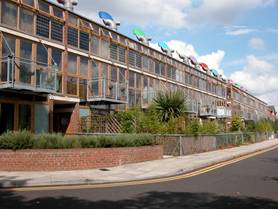 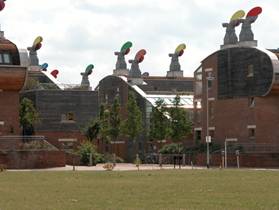
Beddington Zero Energy Development. 2002
This project takes a holistic approach to energy reductions. It uses a combined heat and power plant to provide energy to the complex. Energy requirements are reduced through passive solar heating strategies. The project uses super insulation to assist with heat retention. Air conditioning is not provided. Wind cowls assist with natural ventilation for cooling. Designed by ZEDfactory. |
In addition to targeting renewable energy on a community scale, the UK Low Carbon Residential model is also looking for the incorporation of aggressive passive heating as well as the smaller scale use of solar and wind energy in individual residential projects. Technical progress has been made in the efficiency of micro turbines to supply wind energy to small scale projects. So although lowering CO2 and other greenhouse gas emissions is the primary focus of the UK initiative, the methods do also have a positive sustainable impact on regional issues such as transportation, of both people and products, by reducing distances and reinforcing the sense of community. Consciousness about Global Warming is not the only driving force behind the UK impetus.
There have been significant political issues surrounding a state of “Fuel Poverty” in the UK for many years. Much of the housing stock is very old and poorly insulated. The cost of fossil fuel in the UK and Europe has long been many times higher than the rates charged in North America. Fuel poverty is defined as the point at which a home owner (typically at a lower income level) must choose between heating their home and eating. A household is said to be in fuel poverty if it needs to spend more than 10% of its income on fuel to maintain a satisfactory heating regime (usually 21 degrees Celsius for the main living area, and 18 degrees Celsius for other occupied rooms). In contrast to North America, where fossil fuel prices have been forcibly kept low, high fuel prices in the UK have made consumers and residential neighborhoods more accepting of wind and solar opportunities that can provide a lower cost alternative. Much of the housing stock is very old and poorly insulated. The cost of fossil fuel in the UK and Europe has long been many times higher than the rates charged in North America. Fuel poverty is defined as the point at which a home owner (typically at a lower income level) must choose between heating their home and eating. A household is said to be in fuel poverty if it needs to spend more than 10% of its income on fuel to maintain a satisfactory heating regime (usually 21 degrees Celsius for the main living area, and 18 degrees Celsius for other occupied rooms). In contrast to North America, where fossil fuel prices have been forcibly kept low, high fuel prices in the UK have made consumers and residential neighborhoods more accepting of wind and solar opportunities that can provide a lower cost alternative.
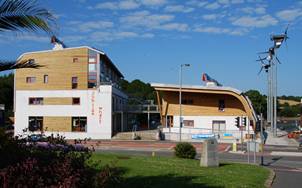 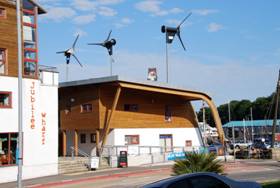
Jubliee Wharf, Penryn, UK. 2006
This zero energy development uses 4 micro turbines to provide power. Evacuated tubes provide solar hot water. The roof has been designed for PV, but no PV is presently installed. Directional wind cowls assist with natural ventilation to the point that no A/C is provided. A 75kW wood pellet boiler provides under floor radiant heating. The building is super insulated with 300mm of insulation netting a U value of 0.1W/m2/ok. Designed by ZEDFactory. |
The 2030 Challenge is a North American based move to reduce the greenhouse gas emissions for all new buildings to zero by the year 2030. The idea was put forth by architect Edward Mazria, one of the early passive and solar pioneers. The fossil fuel reduction targets are aggressive: 60% in 2010; 70% in 2015; 80% in 2020; and 90% in 2025. Carbon-neutral in 2030 means using no GHG emitting fossil fuels to operate buildings. At this point in time, the emphasis for the 2030 Challenge carbon reduction is focused only on operating energy. It presently is not considering the carbon implications of construction, the materials used in the building, the use of the building or associated transportation costs. It is felt that the impact of operational energy is of greater significance as its negative costs to the environment will persist for the life of the building. Although many organizations have adopted the 2030 Challenge, there has yet to be developed a clear method of implementation to achieve its fossil fuel reduction targets. is a North American based move to reduce the greenhouse gas emissions for all new buildings to zero by the year 2030. The idea was put forth by architect Edward Mazria, one of the early passive and solar pioneers. The fossil fuel reduction targets are aggressive: 60% in 2010; 70% in 2015; 80% in 2020; and 90% in 2025. Carbon-neutral in 2030 means using no GHG emitting fossil fuels to operate buildings. At this point in time, the emphasis for the 2030 Challenge carbon reduction is focused only on operating energy. It presently is not considering the carbon implications of construction, the materials used in the building, the use of the building or associated transportation costs. It is felt that the impact of operational energy is of greater significance as its negative costs to the environment will persist for the life of the building. Although many organizations have adopted the 2030 Challenge, there has yet to be developed a clear method of implementation to achieve its fossil fuel reduction targets.
It can be seen that the UK and North American focuses could benefit by being conjoined. The UK has clear sights set on reducing carbon numbers through energy efficiency and the use of renewables, paying less heed to materials, indoor environmental quality, whereas the North American rating systems are non specific about carbon, and focus more in issues of site selection, water, indoor air quality, sourcing of materials, as well as energy.
When designing the building for the type of high level of holistic environmental performance that could lead to a carbon neutral state, there might be considered to be an additive system that consists of “layers of concern” that shape and specify aspects of the design. An examination of the summation of the UK and North American initiatives could result in a complementary set of concerns. This does not infer abandonment of the growing success in the market place of initiatives such as LEED®. It does infer that it will be necessary to target LEED® Platinum and higher to be able to eventually reduce carbon emissions. But even if designing to meet LEED® Platinum, it does infer that the criteria that have been developed will require specific interpretation, extension and calculations to make them effective means to approach reducing our carbon emissions.
|

